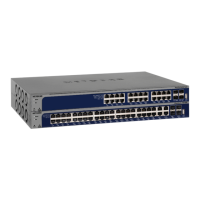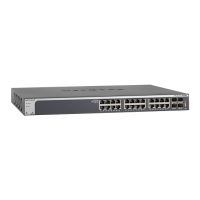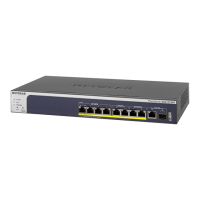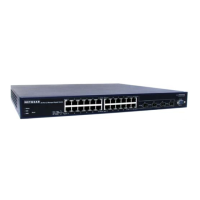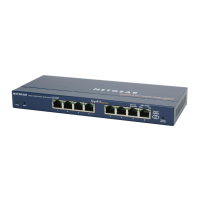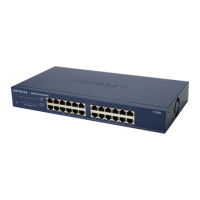Configuration Examples
420
XS708T, XS712Tv2, and XS716T Smart Managed Pro Switch User Manual
definition to convey some QoS characteristics to downstream switches that do not
routinely look at the DSCP value in the IP header.
• Policing. A method of constraining incoming traffic associated with a particular class so
that it conforms to the terms of the TCS. Special treatment can be applied to out-of-profile
packets that are either in excess of the conformance specification or are nonconformant.
The DiffServ feature supports the following types of traffic policing treatments (actions):
• drop. The packet is dropped.
• mark cos. The 802.1p user priority bits are (re)marked and forwarded.
• mark dscp. The packet DSCP is (re)marked and forwarded.
• mark prec. The packet IP Precedence is (re)marked and forwarded.
• send. The packet is forwarded without DiffServ modification.
Color Mode Awareness. Policing in the DiffServ feature uses either color blind or color
aware mode. Color blind mode ignores the coloration (marking) of the incoming packet.
Color aware mode takes into consideration the current packet marking when the switch
determines the policing outcome. An auxiliary traffic class is used in conjunction with the
policing definition to specify a value for one of the 802.1p, secondary 802.1p, IP DSCP, or
IP precedence fields designating the incoming color value to be used as the conforming
color. You can also specify the color of traffic that exceeds the threshold.
• Counting. Updating octet and packet statistics to keep track of data handling along traffic
paths within DiffServ. In this DiffServ feature, counters are not explicitly configured by the
user, but are designed into the system based on the DiffServ policy being created. For
more information, see Monitor the Switch and the Ports on page 357.
• Assigning QoS Queue. Directs a traffic stream to the specified QoS queue. This allows a
traffic classifier to specify which one of the supported hardware queues are used for
handling packets belonging to the class.
• Redirecting. Forces a classified traffic stream to a specified egress port (physical or
LAG). This can occur in addition to any marking or policing action. It can also be specified
along with a QoS queue assignment.
DiffServ Example Configuration
To create a DiffServ class and policy and attach them to a switch interface, follow these
steps:
1. On the QoS Class Configuration page, create a new class with the following settings:
• Class Name. Class1
• Class Type. All
For more information about this page, see Configure a DiffServ Class on page 243.
2. Click the Class1 hyperlink to view the DiffServ Class Configuration page for this class.
3. Configure the following settings for Class1:
• Protocol Type. UDP
• Source IP Address. 192.12.1.0.

